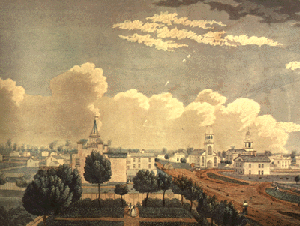MOSES CLEAVELAND'S CAPITOL TOWN
|
Moses Cleaveland and the Land Company never thought of their "capitol town" as anything less than a
city, although it took almost 50 years for a place deserving that name to appear at the mouth of the
Cuyahoga River.
We know from letters that although Cleaveland and his co-proprietors
at first envisioned a major lake port, they soon downsized their hopes
to be more on the scale of Windham, CT, then a prosperous shiretown. See
Windham,
ca.1827(courtesy of Windham GenWeb), and follow its progress at the
Thread City website. Compare it to present day Cleveland
and plans for the "Cleveland Flats."
Also see this map of the Flats, showing where the settlers landed.
|  Cleveland, Ohio, ca. 1833
Cleveland, Ohio, ca. 1833
New York Public Library Picture Collection
|
Map comparisons can be made using "A Plan
of the City of Cleaveland" by Seth Pease on the Cleveland Cartography site. This can be juxtaposed with images of the early
town plans of Philadelphia, Baltimore, Buffalo,
Washington
and New Haven. Which might
have influenced Moses Cleaveland's design? The striking resemblance to New Haven will be apparent. (Washington D.C. will resemble Buffalo.)
Moses Cleaveland was a Yale graduate and therefore familiar with the city. However, unlike the Puritan proprietors who had laid out New Haven, Cleaveland was a Jeffersonian Republican who had campaigned against use of
funds from the sale of the Western Reserve to support the gospel ministry. Does this help explain why he proposed a "public square"
rather than a church-centered green like that of New Haven?
More research and discussion questions: In which states was there still an established (official) church in 1796? Didn't the Federal Constitution's
First Amendment guarantee separation of church and state?
See also Patricia Ansel's (Yale-New Haven Teachers' Insititute) middle school curriculum unit on New Haven history and architecture.
The Colonial section gives background on New Haven's 9 squares. The Federalist section talks about what New Haven
was like when the Connecticut surveyors were laying out "Cleaveland." Students who read this will discover there was a yellow fever epidemic in
New Haven during these years and get an idea of the sorry state that the over-used burying
ground had been brought to. See the New Haven Burying Ground
to find out about the ambitious urban redesign project going on during 1796-7. See it's layout
and read more about Grove Street Cemetery today.
To see what happened to Cleveland's Public Square decades later, read the
Encyclopedia of Cleveland History entry. (Students will want to check out the
Fence War.)
HOME
